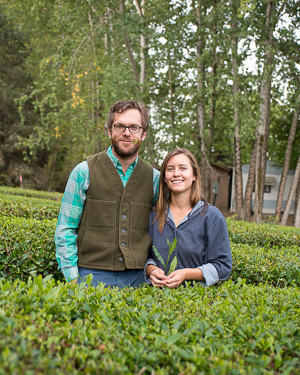
On a small plot of land tucked away on a rarely traveled rural road near Oregon’s Willamette River, a yard sign promotes a once-a-year visitors weekend, the only outward indicator that something special is happening here.
Beyond the sign and a short gravel driveway is Minto Island Tea Company, a nearly half acre plot of land containing Camellia sinensis bushes. More botanic laboratory than tea farm, it’s a 29-year-old science project and the only place in the state of Oregon where tea is being cultivated and sold.
Minto Island Tea Company is equal parts business and passion for Elizabeth Miller and husband Chris Jenkins, who operate the tea farm as part of their larger Minto Island Growers, an organic vegetable farm. It’s less than a mile outside Salem, the state capital, and a world away from the epicenters of tea production.
The project was started by Miller’s father, Rob Miller, and tea expert John Vendeland in 1988 to experiment and see how tea would perform in the Willamette Valley. Elizabeth was there to help on the farm as a child and always expected she would work the land.
“John was really interested in the possibility of domestic tea production,” Elizabeth Miller said, recounting history. “He collected specimens from all over the world, different cultivars—over 200—to establish this test plot. This is a research plot, a genetic bank.
“I never wanted to pursue anything else, so every year in college I came back home and kept working on the farm. I feel like I’m one of the luckier people in the world to do my work that’s also my passion,” Miller said. “I can’t imagine doing anything else.”
Currently, the yield is about 100 lb of tea each year, a blend of what is grown there. But the intention was never to create a production plot.
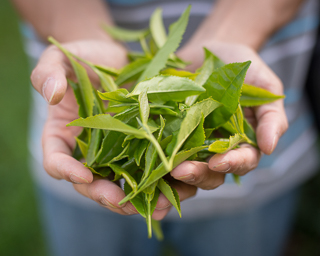
“We’re making whites and greens and blacks from a blend of cultivars. We don’t really have a choice,” she said. “At the same time, we are taking seed collection. You go 10 feet (along the scrubs) and it changes from, say, Yabukita, to some main Japanese varieties. There are some from the original South Carolina plantation that Lipton started, and also specimen teas collected from Hawaii. There’s really a lot of different Camellia sinensis here.”
The small parcel is 98% C. sinensis, with only one Camellia sinensis var. assamica variety in the group. Some of the plants don’t even have names. “The cuttings from South Carolina are only numbers and not named cultivars,” Miller said. “Several Japanese green tea cultivars include Yabukita, Yamatomidori, and Okumidori.”
Agriculture in Oregon’s Willamette Valley dates back as far as recorded human history. The rich soil was deposited more than 15,000 years ago when a miles-long ice dam gave way in what is now Montana and sent a cataclysmic tsunami of ice, mud, and rocks surging across the landscape, gouging out the Columbia River basin. Geologists estimate it all ended seven days later with flooding that extended as far south as what is now Eugene, Oregon, about 120 miles south of today’s Columbia River.
The soil here is naturally acidic and drainage is very good, Miller said. While part of their farm acreage is more susceptible to occasional winter river flooding, the high water doesn’t stay for long.
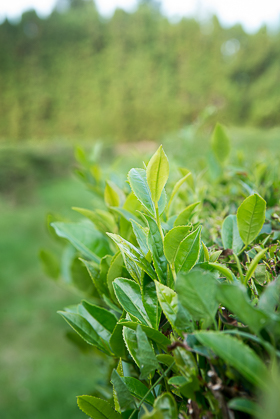 “The Willamette Valley is known for temperate growing conditions, milder wet winters, and dry but not humid summers,” Miller said. “This provides us with a four-month tea-growing season with the first spring pluck in May and the last in early September.”
“The Willamette Valley is known for temperate growing conditions, milder wet winters, and dry but not humid summers,” Miller said. “This provides us with a four-month tea-growing season with the first spring pluck in May and the last in early September.”
The city of Salem and the Minto Island Tea Growers’ plot are located right in the middle of the valley. Hops, filberts, mint, numerous varieties of wine grapes, blueberries, grass seed, and many other crops are grown across the valley and up its slopes.
It was not unusual, then, for Rob Miller and John Vendeland to think this spot in the river’s floodplain held some potential for their tea laboratory.
“I don’t know if there’s anything particular about this soil that’s uniquely suited for tea,” Elizabeth Miller said. “From what I’ve learned, tea grows in a huge diversity of climates and soils. The tea has done well here (as many crops do) but I think it would grow in many different climates in Oregon. We don’t have elevation here but we have a decent growing season.”
Both she and husband Chris were more interested in the vegetable side of the business. “I’m a farmer,” she said. “My father is a very natural and accomplished agricultural entrepreneur and I’m attempting to follow in his footsteps. Chris is the scientist. He’s a very good grower.”
Their Minto Island Growers is a success in its own right, providing vegetables to local farmers markets, their own farm stand down the road from the tea plot, and U-pick opportunities for local residents. They participate in the Community Supported Agriculture (CSA) program.
The tea farm, however, may soon be playing a larger role in the company’s efforts.
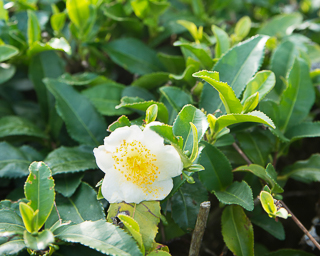
“We started to invest in the tea when we already were putting a lot of energy into CSA, farmers markets, our farm stand, and building a diversified organic vegetable business,” Miller said. “This is exactly the same thing but with tea. It’s small scale, it’s all about the relationship with customers, the transparency, and the local food systems. You’re direct marketing with customers. Our experience with that helped shape our direction with tea.”
That investment ramped up in 2016 when they planted an additional 10 acres on land they lease from Miller’s parents. However, a colder-than-normal winter wiped out most of that planting.
“It was an unusual winter,” she said. “There’s a lot of weed pressure out there. We tried our best to prepare the ground but there were some challenges. We also think we put the plants in the ground a little too young. We should have waited until they were a little bit bigger, a little bit stronger. I think (the cause) was a combination of the size of the plants, the planting conditions, the cold weather, and the weed pressure. I don’t think it was any one primary factor.”
So, in keeping with family tradition, the experimentation continues as surviving plants are nurtured and new ones go into the ground. In the end, they aim to establish 5 to 10 acres of specific cultivars. They intend to plant 4,585 shrubs per acre.
Once the leaves are plucked, another experiment of sorts begins.
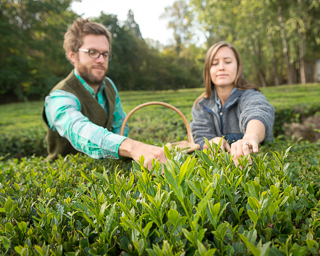 “We are beginning tea processors. The art of tea processing is really complicated. The technical, the artistic, and the craft all come together and we’re just starting to learn about that,” she said.
“We are beginning tea processors. The art of tea processing is really complicated. The technical, the artistic, and the craft all come together and we’re just starting to learn about that,” she said.
Interest in their product continues to grow. They sell what they produce on their website, at their farm stand, and at a Portland farmers market. They also sell plants.
“We just get more and more people asking about the tea,” Miller said. “The attention we keep getting tells us we have a unique opportunity. We have to try to push the project forward.
“We’re surprised that more people haven’t tried to grow Camellia sinensis here in the valley before,” Miller said. “Ornamental camellias are grown all over Oregon and tea is grown all over the world. It’s not really that big of a surprise that tea does well here. That’s what the plot was designed to figure out. Will this cultivar from Japan or this cultivar from China grow here? They’ve all done well. Some do better than others. Some have bigger leaf shapes but they all do well in the environment.”
Photos by Shawn Linehan. Learn more about Minto Island Tea Company: http://mintoislandtea.com/)
***
This article is a part of Tea Journey’s upcoming Tea Discovery issue, click to subscribe.
Hi, liked your interesting article. Chris / Elizabeth are right, tea will grow anywhere. It only needs elevation if the ambient temperature is too hot otherwise to allow good quality without it – i.e. along the equator such as in Uganda and Rwanda. Elevation and latitude are 2 sides of the same coin. Watch the frost tho’. And right again on soils – tea needs pH of 3,5 to 5,5, but it needs lots of nitrogen, being a leaf crop. There are bacteria to fix nitrogen if you want to be organic. Clones? what is it that you are after? high antioxidants thearubigens and theaflavins and theanine [the calming one]. Malawi has excellent clones for high quality and yield. Tea is most eco-friendly crop in the world. Good luck! Chris